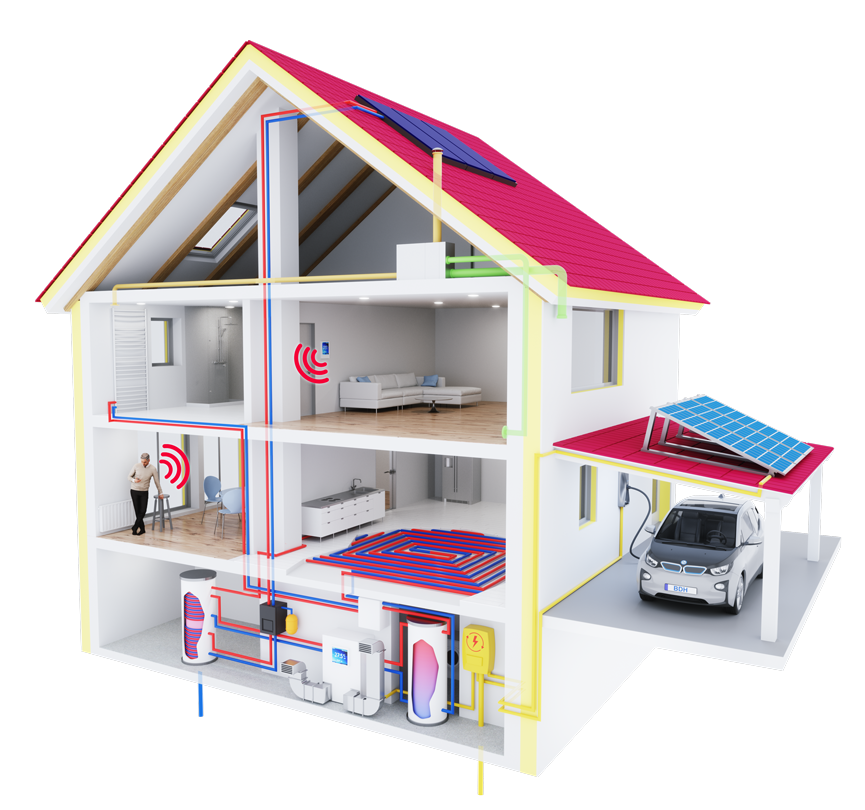The ambient heat, which is present in the soil, groundwater and air, can be utilised for heating or cooling using a heat pump. Heat pumps are highly efficient, very economical and require low maintenance.
Three paths – one goal
There are three types of heat pumps: The brine-water heat pump uses the geothermal energy either via a probe or by a flat plate collector inserted into the ground. Their outputs are very stable because the ground temperature does not vary much during the year. However, the installation cost is comparatively high. A water-water heat pump is even more efficient. Using a suction well, the groundwater is fed upwards to the heat pump, where it dissipates its heat energy. Then it flows back into the ground through an injection well. The air-water heat pump is the easiest to install but not quite as efficient. It extracts energy from the outdoor air – up to a temperature of minus 20° C. Apart from power driven heat pumps, gas heat pumps are also being increasingly used. Regardless of the energy source, heat pumps in combination with embedded floor or wall heating systems are particularly efficient because the system temperatures are lower in this case.
Neben Strom als Antrieb der Wärmepumpe kommen mittlerweile auch Gas-Wärmepumpen vermehrt zum Einsatz. Egal welcher Energieträger, besonders effizient sind Wärmepumpen in Verbindung mit Flächenheizungen, denn hier sind die Systemtemperaturen geringer.
A closed loop
Heat pumps mainly consist of heat collectors and an electrically operated heat pump. The pump ensures that the liquid heat transfer medium transports the heat energy from the collectors to the heater in a closed loop system. This principle is also used in refrigerators, only vice versa. The heat is pumped out from the refrigerator and dissipated into the room, whereas the heat pump absorbs heat from the surroundings and brings it into the house.
Thus, heat pumps operate based on a relatively complex technical principle. This can be explained in a simple manner using the example of a geothermal heat pump:
- A special heat-carrier fluid flows at a very low temperature through the ground collector
- It absorbs the heat from the warm ground, changing its state from liquid to gas.
- This gas is then compressed by a pump using high pressure. This heats it up again intensely – just like the valve of a tube which becomes hot when being inflated.
- Now the hot gas dissipates the heat to the water in the heating system and changes to a liquid state again, but is still under high pressure.
- Before the heat-carrying medium flows back to the collector, the pressure is released and the liquid cools down to its original temperature.
An ice storage tank is another new way of recovering heat. A solar ice storage tank is a concrete reservoir buried in the ground and filled with water, having a network of pipes inside. A frost-resistant fluid that absorbs the heat from the water in the storage tank, flows through the pipes.
The recovery of heat from waste water is also effective. The waste water temperature ranges from 10–20° C during the year, which means that it is an excellent source of heat. A heat exchanger absorbs the energy from the waste water, which is then used by the heat pump for heating.
It is working out
The heat pump requires energy from outside for the compression process. From one kilowatt-hour of electricity, three to five kilowatt-hours of heat is generated. And of course, the energy required for his process can also be generated from renewable sources, for example, a photovoltaic system.

